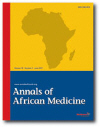
|
Annals of African Medicine
Annals of African Medicine Society
ISSN: 1596-3519
Vol. 5, No. 1, 2006, pp. 52-55
|
 Bioline Code: am06012
Bioline Code: am06012
Full paper language: English
Document type: Research Article
Document available free of charge
|
|
|
Annals of African Medicine, Vol. 5, No. 1, 2006, pp. 52-55
| en |
Pharyngo-oesophageal Foreign Bodies: Implications for Health Care Services in Nigeria
Iseh, K. R.; Oyedepo, O. B. & Aliyu, D.
Abstract
Background:
Pharyngo-oesophageal foreign body is the commonest endoscopic surgical emergency in otorhinolaryngological practice in Nigeria. Its implication in health care services of Nigeria is highlighted from the experiences of Usmanu Danfodiyo University Teaching Hospital Sokoto Nigeria.
Method:
Clinical records of patients seen in the Ear, Nose and Throat department of Usmanu Danfodiyo University Teaching Hospital Sokoto from January 1999 to May 2003 with suspected or confirmed history of foreign body ingestion who were prospectively recruited were reviewed. The patients were subjected to thorough history, clinical examination and radiological investigation of the neck and chest. Rigid pharyngo-oesophagoscopy and removal under general anaesthesia was carried out where indicated while some were observed for the foreign body to be passed in stool.
Results:
A total number of 75 cases were seen. There were 50 males (66.7%) and 25 females (33.3%). Their ages ranged from 6 months - 90 years. Age group of 0-5 years accounted for 53.3%, while 0-10 years accounted for 68%. Coin (65.3%) was the commonest foreign body occurring mainly in the paediatric age group followed by bones (17.3%) and meat bolus (8%) in adults. Meat bolus was the only impacted foreign body amongst the elderly patients aged between 70-90years.The duration of impaction ranged from a few hours to seven years. Compared with other reports, there were no foreign bodies of dental origin, no complications or mortality in their management.
Conclusion:
Pharyngo-oesophageal foreign body impaction is the commonest indication for emergency surgical endoscopy. A functional up to date endoscopic unit backed by skilled manpower and easily accessible to the populace is advised.
Keywords
Foreign bodies, pharynx, oesophagus, implications
|
| |
| fr |
Iseh, K. R.; Oyedepo, O. B. & Aliyu, D.
Résumé
Fond:
Le corps étranger Pharyngo-oesophagien est la chirurgicale endoscopique d'urgence la plus commune dans la pratique otorhinolaryngologique au Nigéria. Son implication dans les services de santé du Nigéria sont accentuées à partir des expériences à l'Hôpital d'Enseignement de l'Université d'Usmanu Danfodiyo, Sokoto, Nigéria.
Méthode:
Les fiches cliniques des malades vues dans le département d'oreille, de nez et de pharynx de l'Hôpital d'Enseignement de l'Université d'Usmanu Danfodiyo, Sokoto à partir de janvier 1999 à mai 2003 avec l'histoire suspectée ou confirmée de l'ingestion de corps étrangers qui ont été prospectivement recrutés étaient passés en revue.Les malades ont été soumis à l'histoire complète, à l'examen clinique et à la recherche radiologique sur le cou et le coffre. Une pharyngo-oesophagoscopie rigide et le déplacement sous l'anesthésie générale ont été effectués où indiqués tandis que certains étaient observés pour le corps étranger à passer dans les selles.
Résultats:
Un nombre total de 75 cas ont été vus. Il y avait 50 mâles (66,7%) et 25 femelles (33,3%). Leurs âges se sont étendus de 6 mois - 90 ans. La catégorie d'âge de 0-5 ans a représenté 53,3%, tandis que 0-10 ans ont représenté 68%. Le bruit de pot fêlé (65,3%) était le corps étranger le plus commun se produisant principalement dans la catégorie d'âge pédiatrique, suivie des os (17,3%) et du bol de viande (8%) dans les adultes. Le bol de viande était le seul corps étranger effectué parmi les vieux malades âgés entre 70-90 ans. La durée de l'impaction s'est étendue de quelques heures à sept ans. Comparé à d'autres rapports, il n'y avait aucun corps étranger d'origine dentaire, aucunes complications ou mortalité dans leur traitement.
Conclusion:
l'impaction de corps étranger Pharyngo-oesophagien est l'indication la plus commune pour l'endoscopie chirurgicale de secours. Une unité endoscopique récente et fonctionnelle soutenue par la main d'oeuvre habile et facilement accessible à tout le monde est conseillée.
Mots Clés
Corps étrangers, pharynx, eosophage, implications
|
| |
© Copyright 2006 - Annals of African Medicine
Alternative site location: http://www.annalsafrmed.org
|
|
